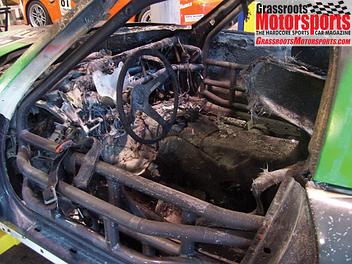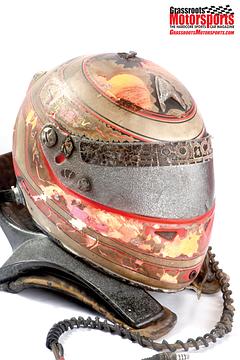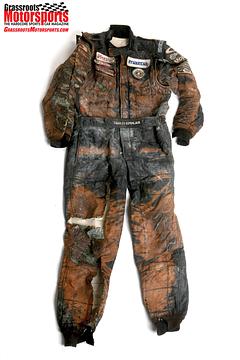Fighting Fire
by Charles Espenlaub From the April 2010 issueOn December 5, 2009, I was buzzing around Thunderhill Raceway in the No. 19 Team MER Super Mazda MX-5 for NASA’s seventh annual 25-hour race. I was having a blast and had high hopes of defending our overall win from the previous year. World Challenge power and numerous other updates gave us one fast Mazda Miata.
At about the seven-hour mark, I was going into Turn 8 at approximately 105 mph when the biggest test of my life unfolded in mere seconds: My car exploded in a giant fireball. It was a test of every survival skill that I have learned to date, the culmination of all my learned instincts. Fortunately, I’m here to tell you about it.
Life Lessons
I come from an aviation background, and my father taught me how to fly at an early age. When I was 7 or 8, I remember my father helping me into the glider when I asked him a seemingly childish question: “Why do we need seat belts?”
His reply: “A seat belt is like a parachute; if you need it and don’t have it, you will probably never need it again.”
I don’t know where he got that statement from, but it stuck in my head as a lesson about the importance of safety gear. I believe it’s true regardless of the activity.
Hence, I am a big advocate of always wearing the right gear, which must be in perfect shape with no holes, no excessive wear, etc. I insist on a top-of-the-line three-layer suit, full-faced helmet, HANS device, gloves and full-length Nomex underwear: top, bottom, socks and balaclava. Note: In particular, nothing is worn underneath the suit that can melt or is flammable.
One of the great things about this sport is learning from all of the people I’ve met. Driving a variety of cars in different series, working with various teams, consulting for safety companies, and teaching at different schools has introduced me to valuable lifesaving knowledge. Everyone from the seasoned pro to the first-day student has taught me valuable lessons that allowed me to pass my test of survival.
The night before the race, as we were preparing the seating position and belts for the driver changes, I took a few minutes—as I always do—to familiarize myself with the fire system, belts, window net, kill switch, door handle and general layout of the car.
I learned to do this after years of listening to stories from veteran drivers who have survived some bad situations. Also, watching novices simply trying to get out of a car during a pit stop can show that this task isn’t as easy as it sounds.
In the SCCA’s World Challenge series, in fact, we have to do an exit test every year for every car that we drive. We get 15 seconds to go from race-ready and belted-in to outside the car.
I believe that I still hold the record for quickest exit at just under five seconds. That exit involved a bit of bleeding, but it prepared me for surviving what happened at Thunderhill.
From Bad to Worse
At Turn 8, the car started filling up with smoke and fumes. “Okay, no big deal,” I thought, “I’ve been through this numerous times.” I put down my visor and called the crew to tell them there was a problem with the car. I was just a few seconds away from corner station 9, where there was help.
Then, in an instant, a fireball erupted in the car. I thought to myself, “Wow, this sucks!” as I reached for the fire system’s pull handle, easily within reach on the left-side A-pillar. (Thank you, Jules.)
The flames were soon gone, the heat dissipated, and as I slowed down for the station I hit the kill switch. I was still thinking that the situation wasn’t a problem, as there was still manageable hope we could fix it and finish the race.
As I slowed down to leave the track and head for the corner station, my right hand reached for the belt release. At that same moment, BOOM, there was a big explosion.
In an instant there was intense, searing bright light, lots of heat, and amazingly dead silence. My eyes were forced closed, but I could still tell that it was incredibly bright in the car. The heat was so intense it was unbearable.
Houston, we now have a problem—a big problem.
I couldn’t see, I couldn’t breathe, and I am not embarrassed to say that at this point I was scared. For the first time ever in a race car, I knew without a doubt that I had to get out now in order to survive—right now!—or I was going to die. The heat started to hurt really, really bad—excruciatingly bad.
Learned instincts started to play out. I dropped the window net, but as I tried to get up I couldn’t, realizing I never undid the belts. I must have picked up my arm as the fire erupted from the middle of the car.
I released the belt with my right hand while I opened the door with my left. As I jumped out, I pulled myself out by grabbing the roll cage. At that moment, I had a profound thought: “Wow, that cage is hot.”
I was still in flames as I ran from the car, so I did the stop, drop and roll routine. (Thank you, Dick Van Dyke.) As I was sprayed with cool, refreshing water, I could finally start breathing again. (Thank you, safety workers.) I got a helicopter ride to the hospital, where I was treated for second-degree burns on both hands and my right arm. A few weeks of healing, and I’d be as good as new, ready for Daytona. I am one lucky duck! (Thank you, everyone involved in my care.)
Be Safe, Be Fast
I have told this story many times since that night, trying to emphasize the importance of having the proper safety equipment in good to excellent condition and having enough practice to make the procedures a learned instinct.
I cannot tell you what caused the fire. Fortunately this was a rather rare occurrence, but one that any driver should be—must be!—ready for at any time. If you look at the accompanying photographs or get a chance to see this equipment in person, you will have no doubt that the gear was essential in saving my life.
Think about what it takes to melt a helmet, yet the searing flames never penetrated my gear. My burns were all from heat transfer. If I were wearing an open-faced helmet or a simple T-shirt as some do when on track, I definitely would not have survived this ordeal.
Now, bear in mind that this was a new car with all-new components, built and prepped by a championship-winning team. I was wearing every possible piece of safety equipment, not just the required items. Everything was in nearly new condition.
I regularly practice my exits and I am tested at least once a year on my ability to get out of a car in a hurry. I have many years of professional driving experience and work with safety companies. I always familiarize myself with the car’s safety equipment before driving. (Ever forget to pull the safety pin on your fire bottle before a session?)
Remember, fire burns just as hot on a test day as it does on a race day, so wear all your gear. How fast can you get out of your car while blindfolded and holding your breath? Have you practiced fast exits? Are you ready? Please think about it. Be fast and safe, and always wear all of your safety gear.












No comments:
Post a Comment